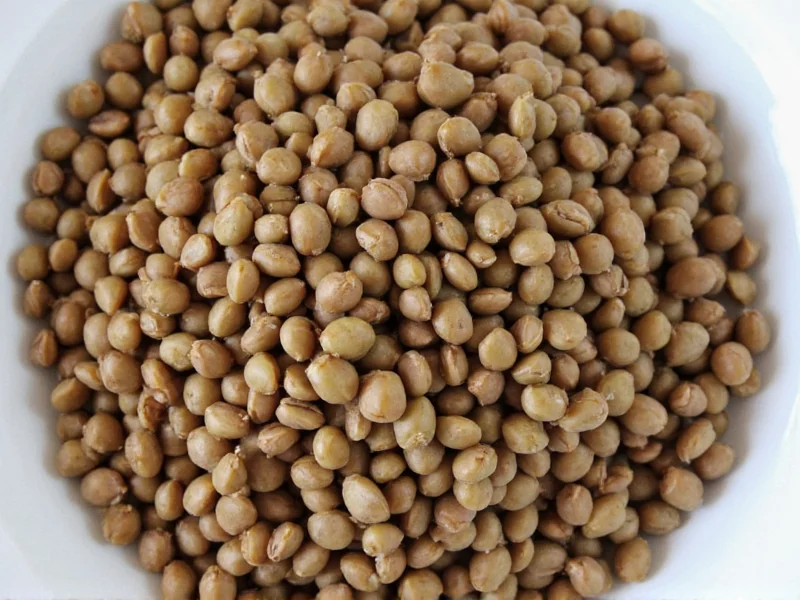Properly prepared dried lentils form the foundation of countless nutritious dishes worldwide. Unlike canned alternatives, dried lentils offer superior texture control and cost efficiency when prepared correctly. This comprehensive guide reveals professional techniques for achieving perfect results with every batch, whether you're making hearty soups, vibrant salads, or protein-packed side dishes.
Understanding Lentil Varieties and Their Needs
Not all lentils behave the same during cooking. Recognizing these differences is crucial for how to prepare dried lentils successfully. Each variety has unique cooking properties that affect preparation time, water absorption, and final texture. Understanding these characteristics prevents common mistakes like overcooking delicate red lentils or undercooking sturdy black varieties.
Step-by-Step Preparation Method
Follow this professional approach for consistently excellent results when you cook dried lentils without soaking. While some beans require extensive soaking, most lentils cook efficiently with minimal preparation.
1. Sorting and Rinsing
Pour lentils onto a light-colored surface to spot debris. Remove any stones, shriveled pieces, or foreign matter. Rinse thoroughly in a fine-mesh strainer under cold running water, gently swishing to remove dust. This critical step ensures proper preparation of dried lentils and prevents unpleasant surprises in your finished dish.
2. Water Ratio Guidelines
The ideal water-to-lentil ratio varies by type. Use this reference for cooking different lentil varieties perfectly:
| Lentil Type | Water Ratio | Cooking Time | Best Uses |
|---|---|---|---|
| Red/Yellow | 1.5:1 | 15-20 minutes | Curries, dals, purees |
| Green/Brown | 2.5:1 | 20-30 minutes | Soups, stews, salads |
| Black (Beluga) | 3:1 | 25-30 minutes | Salads, side dishes |
| Puy (French) | 2.5:1 | 25-30 minutes | Salads, gourmet dishes |
3. Cooking Process
Combine sorted lentils and cold water in a heavy-bottomed pot. Bring to a gentle boil, then reduce heat to maintain a steady simmer. Avoid adding salt during initial cooking as it can toughen lentils. For enhanced flavor, add aromatics like bay leaves, garlic, or onions at this stage. Stir occasionally to prevent sticking.
4. Testing for Doneness
Begin checking lentils 5 minutes before expected completion time. Perfectly cooked lentils should be tender but retain their shape (except red/yellow varieties, which naturally break down). They should have no chalky center when bitten. Overcooked lentils become mushy and lose nutritional value.
5. Finishing Touches
Once cooked, immediately drain excess liquid. Add salt and acid (lemon juice or vinegar) to enhance flavor and prevent further cooking. For salads, rinse briefly under cold water to stop the cooking process and maintain texture.
Avoiding Common Preparation Mistakes
Many home cooks encounter issues with how to prevent mushy lentils or uneven cooking. These professional tips solve frequent problems:
- Don't skip rinsing - removes field dust that causes digestive discomfort
- Avoid vigorous boiling - maintains lentil integrity
- Add acidic ingredients late - prevents toughening during cooking
- Check frequently - cooking times vary by altitude and pot type
- Use fresh lentils - older lentils take longer to cook and may never soften properly
Flavor Enhancement Techniques
Elevate your dried lentil preparation with these chef-recommended methods. While basic cooking provides nutritional benefits, strategic flavor building creates memorable dishes. Add whole spices like cumin seeds or coriander to the cooking water for subtle infusion. For deeper flavor, sauté aromatics before adding lentils and water. Finish with fresh herbs and a drizzle of quality olive oil for restaurant-quality results.
Storage and Reheating Guidelines
Properly stored cooked lentils maintain quality for meal prep. Cool completely before transferring to airtight containers. Refrigerate for up to 5 days or freeze for 3 months. When reheating, add a splash of water to restore moisture. Never leave cooked lentils at room temperature for more than 2 hours to prevent bacterial growth. These practices ensure your prepared dried lentils remain safe and delicious.
Practical Applications
Mastering how to prepare dried lentils opens culinary possibilities. Use perfectly cooked green lentils in Mediterranean salads with feta and olives. Transform red lentils into creamy dals with coconut milk and spices. Create protein-packed black lentil burgers that hold together beautifully. The texture control you gain from proper preparation makes lentils versatile for both hearty mains and delicate side dishes.
Frequently Asked Questions
Do dried lentils need to be soaked before cooking?
Most dried lentils don't require soaking, unlike other legumes. Red and yellow varieties cook quickly without soaking (15-20 minutes). Green, brown, and black lentils also cook well without soaking (20-30 minutes). Soaking isn't necessary for digestibility with lentils, though some prefer a 1-2 hour soak to slightly reduce cooking time.
Why do my lentils keep turning out mushy?
Mushy lentils typically result from overcooking, using too much water, or adding salt too early. Red and yellow lentils naturally break down, but green and brown varieties should maintain shape. To prevent mushiness: use correct water ratios, avoid vigorous boiling, add salt after cooking, and check for doneness starting at 15 minutes. Older lentils may also become mushy more easily.
Can I cook lentils in a rice cooker or Instant Pot?
Yes, lentils work well in both appliances. In a rice cooker, use a 1.5:1 water ratio for red lentils or 2:1 for other varieties, and cook on regular setting. In an Instant Pot, use 1 cup lentils to 1.5 cups water, cook on high pressure for 8-10 minutes (red) or 12-15 minutes (other varieties), followed by a 10-minute natural release. Both methods produce consistent results for how to prepare dried lentils efficiently.
How can I improve the digestibility of cooked lentils?
To enhance digestibility when you prepare dried lentils, always rinse thoroughly to remove oligosaccharides that cause gas. Adding a strip of kombu seaweed during cooking helps break down complex sugars. Cooking with digestive spices like cumin, ginger, or fennel also improves tolerance. Avoid adding acidic ingredients until the end of cooking, as they can slow the breakdown of hard-to-digest compounds.











 浙公网安备
33010002000092号
浙公网安备
33010002000092号 浙B2-20120091-4
浙B2-20120091-4